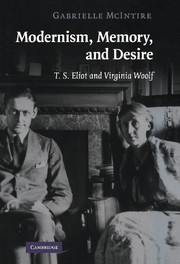Book contents
- Frontmatter
- Contents
- Illustration
- Acknowledgments
- Introduction
- 1 An unexpected beginning: sex, race, and history in T. S. Eliot's Columbo and Bolo poems
- 2 Mixing memory and desire: rereading Eliot and the body of history
- 3 Eliot, eros, and desire: “Oh, do not ask, ‘What is it?’”
- 4 T. S. Eliot: writing time and blasting memory
- 5 Virginia Woolf, (auto)biography, and the eros of memory: reading Orlando
- 6 Other kinds of autobiographies: sketching the past, forgetting Freud, and reaching the lighthouse
- 7 Remembering what has “almost already been forgotten”: where memory touches history
- Epilogue
- Notes
- Index
1 - An unexpected beginning: sex, race, and history in T. S. Eliot's Columbo and Bolo poems
Published online by Cambridge University Press: 22 September 2009
- Frontmatter
- Contents
- Illustration
- Acknowledgments
- Introduction
- 1 An unexpected beginning: sex, race, and history in T. S. Eliot's Columbo and Bolo poems
- 2 Mixing memory and desire: rereading Eliot and the body of history
- 3 Eliot, eros, and desire: “Oh, do not ask, ‘What is it?’”
- 4 T. S. Eliot: writing time and blasting memory
- 5 Virginia Woolf, (auto)biography, and the eros of memory: reading Orlando
- 6 Other kinds of autobiographies: sketching the past, forgetting Freud, and reaching the lighthouse
- 7 Remembering what has “almost already been forgotten”: where memory touches history
- Epilogue
- Notes
- Index
Summary
I keep my countenance,
I remain self-possessed
Except when a street-piano, mechanical and tired
Reiterates some worn-out common song
With the smell of hyacinths across the garden
Recalling things that other people have desired.
Are these ideas right or wrong?
T. S. Eliot, “Portrait of a Lady”One day Columbo and the queen
They fell into a quarrel
Columbo showed his disrespect
By farting in a barrel.
The queen she called him horse's ass
And “dirty Spanish loafer”
They terminated the affair
By fucking on the sofa.
T. S. Eliot, Inventions of the March HareOne of the most striking instances of T. S. Eliot's mixing of memory and desire occurs in his rendering of the history, legacy, and cultural memory of early European colonial expansion. In the period from 1909 to 1922 when Eliot was writing and publishing poems such as “The Love Song of J. Alfred Prufrock,” “Portrait of a Lady,” “Preludes,” and The Waste Land – poems that firmly established his reputation as one of the major poets of the century – he was simultaneously composing a long cycle of intensely sexual, bawdy, pornotropic, and satirical verse that has only recently come to light.
- Type
- Chapter
- Information
- Modernism, Memory, and DesireT. S. Eliot and Virginia Woolf, pp. 10 - 38Publisher: Cambridge University PressPrint publication year: 2008



